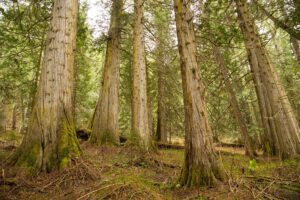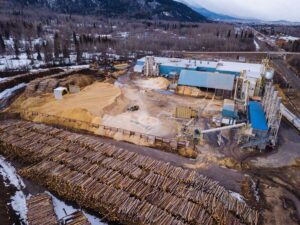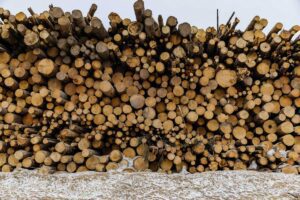Burning wood pellets for electricity
As more countries join the frantic race to get off of coal, many are turning to biomass-burning – often in the form of burning wood pellets to meet their energy needs. Wood pellets made from forests in Canada, the United States, and other countries are shipped overseas to countries like the United Kingdom and Japan, where they are burned.
Biomass-burning countries and the companies that fuel them are exploiting an international carbon accounting loophole that allows them to count their emissions as carbon neutral. But scientists worldwide have proven that in fact, burning forest biomass emits more carbon dioxide at the smokestack than coal. Countries staking their energy future on wood pellets are really just replacing one highly polluting fuel with another.
Flawed carbon accounting rules mean the forest biomass industry that supplies countries with wood pellets can grab green subsidies. Without these subsidies, the industry could collapse. To make matters worse, the industry in Canada is targeting the last remaining primary and old growth forests to keep up with the demand. Canada is one of the top exporters of wood pellets in the world. A growing body of evidence proves that the industry logs whole trees and grinds them into pellets. This practice helps push biodiversity thresholds to the point of no return and eliminates one of the best defenses we have against climate change and wildfires. Old growth and primary forests capture and store more carbon than logged forests. The forests they log and burn may never return as we know them.
The wood pellet industry is more likely to put their polluting pellet mills in poor and Black communities, as seen in the US southeast. This is environmental racism as the industry treats these communities as dumping grounds. The dust and debris from the mills can cause or exacerbate health conditions from asthma, heart disease, to cancer.
Forests also play an important role in safeguarding communities from the worst impacts of human induced climate change, like increasingly large and intense forest fires and other unnatural disasters, such as flash floods, water shortages, and heat waves that forests help regulate.
The shift to a renewable energy-powered future must not include forest biomass. It’s time for the Canadian government to cut taxpayer handouts to biomass corporations and redirect funds to truly sustainable energy sources like wind and solar, and provide more support for Indigenous-led forest stewardship, land use, and restoration projects. To show real global leadership, Canada should push for updates to global carbon accounting loopholes that mask the true climate impacts of burning biomass for energy. It’s time to move beyond burning – forests left standing are the real climate solution.
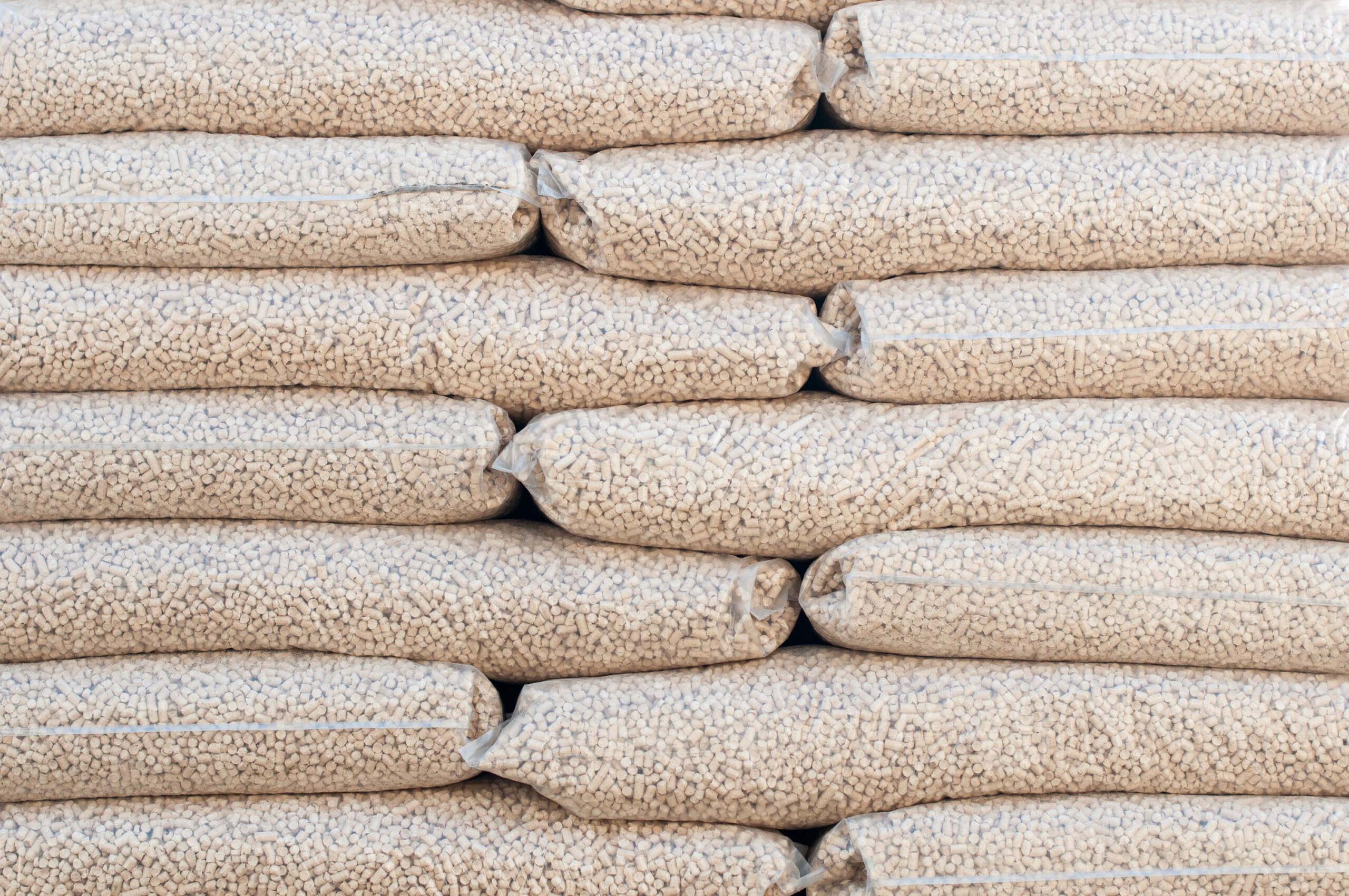
Beyond Burning
This animated video powerfully narrated by Dame Emma Thompson, exposes the propaganda that governments and the global forest biomass industry has been peddling. Public money should not be spent on subsidies for climate-polluting corporations. Tell your governments: it’s time to move beyond burning and invest in genuine climate solutions.
Latest News
View AllTake Action
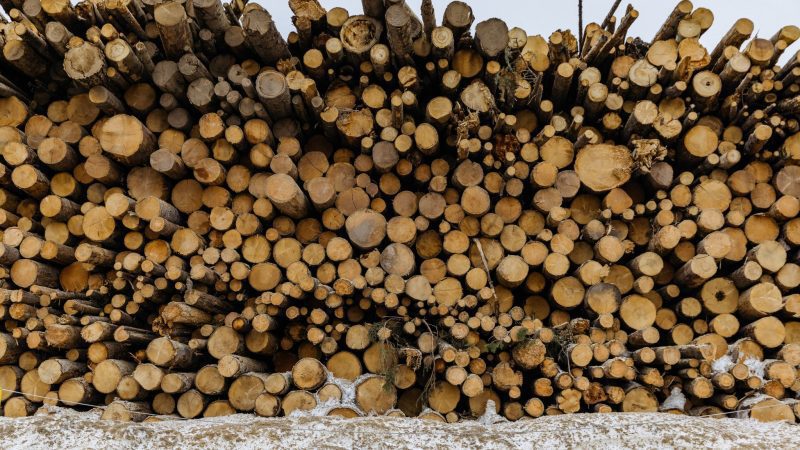
Follow Australia’s lead and reject forest biomass as a false climate solution
Trudeau and Biden, we shouldn’t have to tell you that logging forests and burning them for electricity is a bad idea. And we REALLY shouldn’t have to tell you that taxpayer handouts to the companies burning our forests is a terrible idea. It’s time to cut ties with the biomass scandal and invest in real climate solutions.

Stop burning forests: send an email to the federal government
Did you know the Canadian federal government is allowing forests in B.C. to be logged and burned overseas for electricity?

Stop logging whole trees for wood pellets
Sign the petition calling on decision makers to act now
Resources
FAQs
Biomass is organic matter produced by plants and trees. In this context this material is then burned to create electricity.
Forest biomass is any plant material derived from forests. Woody biomass is the main form of forest biomass burned by power stations to create energy. It consists of trunks and branches that are ground up, dried and formed into wood pellets.
Forest biomass is ground, dried, and formed into wood pellets that are then burned in a power station. These power stations are often existing coal-fired power stations and either co-fired with wood pellets or only wood pellets to produce electricity.
Countries have forest laws and regulations that apply to biomass as they do to other forest products. However, governments often lack the resources to enforce forest laws and regulations. Having a set of forest laws and regulations does not mean that a forest is being responsibly or sustainably logged.
Yes. The process of logging, transporting, storage, drying and grinding wood to make pellets generates several types of pollution. Logging impacts water resources, potentially polluting them with oil, gasoline, and pesticides, as well as soil runoff. Transportation produces air pollution from vehicle exhaust from trucks and shipping including carbon emissions. Grinding wood generates dust particles that have human health impacts, affecting people’s lungs and exposing them to carcinogens.
No. From the logging of primary forests, to degrading a forests’ ability to store and capture carbon to emitting pollutants, including carbon dioxide and driving climate change, forest biomass is not environmentally friendly.
No. Burning wood in place of coal is a retrograde step that often emits more carbon dioxide than coal at the smoke stack and degrades the very forests that should be storing and capturing carbon to combat the climate crisis.
No. Logging and burning biomass instantly emits CO2 into the atmosphere, but it takes forests hundreds of years to recover carbon — and some never will. Forested areas that have matured for centuries such as old growth and primary forests are able to sequester more carbon than cut and re-planted areas.
Numerous studies indicate that converting primary forests to managed forests degrades forest ecosystems and impacts biodiversity. In British Columbia, for example, less than half the original extent of 25 million hectares of old growth forests remain and of that only 35,000 hectares of forest with the largest, most productive old growth forests remain. Yet the biomass industry has been shown to be taking whole trees directly from clearcut old growth forests.
Some of the key players in the wood pellet market include Drax Group Plc, Enviva Partners LP, AS Graanul Invest, Fram Renewable Fuels LLC, and Segezha Group JSC, among others.
In Canada, Drax has a virtual monopoly with a dozen wood pellet mills in British Columbia and Alberta. Drax exports around 30% of these pellets to the UK to burn in their power station. Around 70% of the wood pellets are now being shipped to Japan to be burnt alongside coal for power production. Drax receives over £600m a year in subsidies, paid for by UK energy users. Without the subsidies this industry would not be profitable. Subsidies are due to end in 2027, but Drax is begging for more.
US-based Enviva, is the world’s largest wood pellet producer. Enviva declared bankruptcy with debts of over $2 billion, in March 2024. A whistleblower says it will continue failing to meet its wood pellet contract obligations, and that its production facilities — plagued by chronic systemic manufacturing problems — will continue underperforming. Enviva is lobbying the US Government for a bail out.
Burning wood for energy produces at least as much carbon dioxide as burning coal. Disturbingly, under international carbon accounting guidance, forest biomass emissions are not counted as emissions at the power plant, unlike fossil fuels that rightly have to show the full carbon cycle in the accounting. This has created a false impression of zero emissions for biomass energy compared to burning fossil fuels. Oddly, the country burning biomass then claims emissions reductions.
Failure to account for emissions from burning biomass in the energy sector is resulting in a dramatic expansion of the biomass energy industry. Having already doubled to 14 million tonnes in the preceding decade, global supply and demand for biomass will exceed a 250% increase by 2027, to well over 36 million tonnes.
Biomass energy dominates ‘renewable’ energy production, dwarfing wind and solar and undermining their prospects by soaking up subsidies and incentives that should be applied to genuinely low emissions technologies.
As biomass is increasingly sourced from outside the big biomass energy consumers of Europe, the UK, South Korea and Japan, countries in the poorer Global South, will bear responsibility for the emissions from biomass. This is climate colonialism writ large.

Make a Difference
We have less than ten years to prevent irreversible harm from climate change. Let’s secure a safer planet together.
Ways To Give
